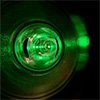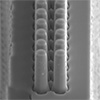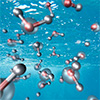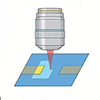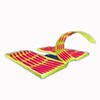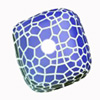Feb 26, 2024 (Nanowerk News) A radical new type of touch sensor for robotics and other bio-mimicking (bionic) applications is so sensitive it works even without direct contact between the sensor and the objects being detected. It senses interference in the electric field between an object and the sensor, at...
Graphene micro supercapacitors enhance flexibility and performance in wearable technology
Feb 26, 2024 (Nanowerk Spotlight) The proliferation of wearable devices—from smart watches to AR glasses—necessitates ever-smaller on-board energy solutions that can deliver bursts of power while remaining unobtrusive. Rigid coin batteries restrict device flexibility and ergonomics. Leading microscale alternatives include micro-supercapacitors (MSCs), which store and discharge energy rapidly owing to...
Laser-focused look at spinning electrons shatters world record for precision
Feb 26, 2024 (Nanowerk News) Scientists are getting a more detailed look than ever before at the electrons they use in precision experiments. Nuclear physicists with the U.S. Department of Energy’s Thomas Jefferson National Accelerator Facility have shattered a nearly 30-year-old record for the measurement of parallel spin within an...
Steering and accelerating electrons at the microchip scale
Feb 26, 2024 (Nanowerk News) Stanford researchers are getting closer to building a tiny electron accelerator based on “accelerator-on-a-chip” technology with broad potential applications in studying physics as well as medical and industrial uses. The researchers have demonstrated that a silicon dielectric laser accelerator, or DLA, can now both speed...
A new theoretical development clarifies water’s electronic structure
Feb 26, 2024 (Nanowerk News) There is no doubt that water is significant. Without it, life would never have begun, let alone continue today – not to mention its role in the environment itself, with oceans covering over 70% of Earth. But despite its ubiquity, liquid water features some electronic...
Metal scar found on cannibal star
Feb 26, 2024 (Nanowerk News) When a star like our Sun reaches the end of its life, it can ingest the surrounding planets and asteroids that were born with it. Now, using the European Southern Observatory’s Very Large Telescope (ESO’s VLT) in Chile, researchers have found a unique signature of...
Researchers hacked a 3D printer to speed up fabrication of bioelectronics
Feb 26, 2024 (Nanowerk News) A research team at KTH Royal Institute of Technology and Stockholm University reported a simple way to fabricate electrochemical transistors using a standard Nanoscribe 3D microprinter. Without cleanroom environments, solvents or chemicals, the researchers demonstrated that 3D microprinters can be hacked to laser print and...
Novel method for easy and quick fabrication of biomimetic robots with life-like movement
Feb 26, 2024 (Nanowerk News) Ultraviolet-laser processing is a promising technique for developing intricate microstructures, enabling complex alignment of muscle cells, required for building life-like biohybrid actuators, as shown by Tokyo Tech researchers. Compared to traditional complex methods, this innovative technique enables easy and quick fabrication of microstructures with intricate...
Scientists realise new method for determining quantum states
Feb 25, 2024 (Nanowerk News) Scientists at Paderborn University have used a new method to determine the characteristics of optical, i.e. light-based, quantum states. For the first time, they are using certain photon detectors - devices that can detect individual light particles - for so-called homodyne detection. The ability to...
Interface-engineered molybdenum oxide catalyst significantly boosts sustainable amine synthesis
Feb 25, 2024 (Nanowerk Spotlight) Secondary amines are an indispensable category of chemicals with extensive applications across industries such as pharmaceuticals, agrochemicals, and polymers. As the demand for amines continues to grow, researchers have been investigating efficient and sustainable methods to synthesize these compounds. A particularly promising approach is through...



